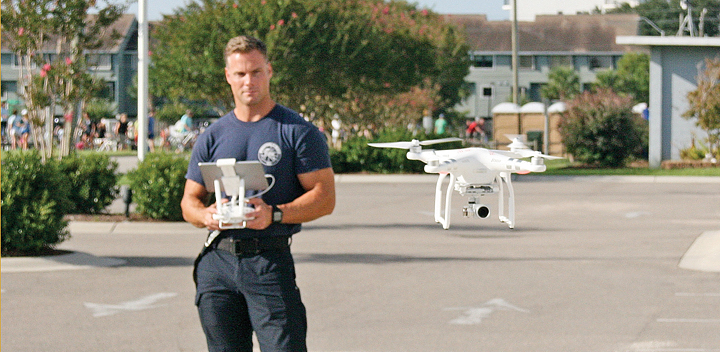When a swimmer went missing off Wrightsville Beach on June 26, lifeguards and police patrolled up and down the beach with trucks, all-terrain vehicles and Jet Skis. A day later, the Wilmington Police Department flew in its SABLE helicopter over the beach, looking for signs of the swimmer that was never found.
For rescues and incidents such as this one, a new tool available to the Wrightsville Beach Fire Department will quickly give rescuers an eye-in-the-sky that could be crucial.
As part of an academic study, the fire department has been awarded use of a Phantom 3 Advanced unmanned aerial vehicle. The drone, with its 360-degree rotating high-definition camera, can help Wrightsville Beach first responders in a variety of rescue and emergency situations.
Fire Chief Glen Rogers said this summer presented several examples of incidents where a drone would be useful. For the missing swimmer, he was never found and is believed to have drowned and not surfaced, but an aerial search after he was reported missing might have led to his discovery.
In another case from this summer, rescuers spent several minutes searching for a missing swimmer in Masonboro Inlet who had grabbed onto the jetty rocks, where the drone could have given rescuers a quicker scan of the search scene.
With a range of 2.1 miles, the drone could have been used for emergency response when a U.S. Marine Corps jet crashed off of Wrightsville Beach in May, when lifeguards were the first to reach the crash site.
The program, run by firefighter Sam Proffitt, will help other departments across the country implement their own drone programs as well. Proffitt first examined the utility of UAVs for first responders as part of the public health graduate degree he recently earned from Pennsylvania State University. To continue the study, the university awarded two drones to local departments for study — one for Wrightsville Beach and one for the Carolina Beach Fire Department.
Both locations have advantages that make them ideal for study, Proffitt said, since both lie outside of the 5-mile radius of Wilmington International Airport, where drone flight above 400 feet is prohibited.
There are other restrictions on operating the unmanned aerial vehicle. For example, firefighter Mike Arthur is a licensed pilot and must be on scene whenever the drone is use, though he doesn’t have to be at its controls. Proffitt is the only other firefighter certified to pilot the drone, which retails for about $600, but others will receive training, he said.
Proffitt will write a study on the drone’s use for Penn State University, which he said will be instructive for other departments as they evaluate ways to utilize the emerging new technology. Other organizations are also interested in the study, including the nonprofit research organization RAND Corporation, Proffitt said.
“We’re working to create a cookie-cutter, step-by-step process that other departments can use to determine how to implement a UAV,” Proffitt said.
In conducting the program, Proffitt said the fire department will be working through a number of issues that come with it.
For example, there will be rules on how photos and videos can be used from operations. The fire department analyzed, but deleted, images taken during the Sept. 17 swim portion of the Wilmington YMCA Triathalon, for which nearly 600 competitors swam the waters between the Blockade Runner Beach Resort and Sea Path Marina.
The Wrightsville Beach Police Department won’t be authorized to use it, chief Dan House said, but any visual evidence observed in the course of unrelated rescue operations could be used in some cases.
Email [email protected]




